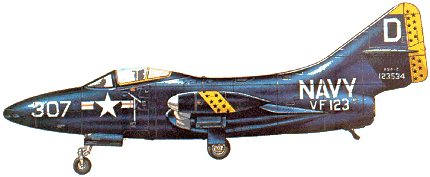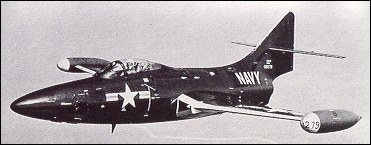|
| The original layout of this single-seat carrier-based fighter provided for the installation of four wing-mounted Westinghouse 19XB-2B (Navy J30) axial-flow jets. But this arrangement was abandoned in favour of one fuselage-mounted high-powered turbojet engine before prototype construction began, a change prompted by the successful tests conducted by the Navy in December 1946 with two imported Rolls-Royce Nene engines.
The first prototype XF9F-2 was powered by an imported Nene engine and flew for the first time on 24 November 1947. The second prototype was similarly fitted, but the third (the XF9F-3) had an Allison J33 engine. Production aircraft were divided between Nene and Allison-powered models, the former engines licence-built by Pratt & Whitney as J42s.
The first production F9F-2, powered by a 22.24kN J42-P-6, flew for the first time on 24 November 1948. The 20.46kN J33-A-8-powered prototype flew for the first time on 15 August 1948 and a total of 418 of both versions were built. However the F9F-2 proved to be the better version and the F9F-3s were re-engined to F9F-2 standard. The F9F-4 (73 of which were ordered originally) was powered by an Allison J33-A-16 engine, but none was completed and the contracts were combined with those for more than 580 27.80kN Pratt & Whitney J48-P-4/6A-engined F9F-5s (which flew for the first time on 21 December 1949). The F9F-5P was a photographic-reconnaissance version with a longer camera nose.
Panthers are remembered in US Navy history as their first jet fighter to be used in combat, introduced into the Korean War on 3 July 1950, as well as for recording a victory against an enemy jet aircraft, a MiG-15, on 9 November 1950.

| MODEL | F9F-5 |
| CREW | 1 |
| ENGINE | 1 x Pratt & Whitney J48-P-6A turbo-jet, 27.8kN |
| WEIGHTS |
| Take-off weight | 8492 kg | 18722 lb |
| Empty weight | 4603 kg | 10148 lb |
| DIMENSIONS |
| Wingspan | 11.58 m | 38 ft 0 in |
| Length | 11.84 m | 39 ft 10 in |
| Height | 3.73 m | 12 ft 3 in |
| Wing area | 23.23 m2 | 250.05 sq ft |
| PERFORMANCE |
| Max. speed | 932 km/h | 579 mph |
| Cruise speed | 774 km/h | 481 mph |
| Ceiling | 13045 m | 42800 ft |
| Range | 2092 km | 1300 miles |
| ARMAMENT | 4 x 20mm cannon, 2 x 454kg bombs or 6 x 127mm missiles |
 | A three-view drawing of F9F-2 Panther (1278 x 902) |
| Nick Mazzocca, e-mail, 05.02.2024 20:46 Was Ted as good in the air as he was at home plate reply | | Nick Mazzocca, e-mail, 05.02.2024 20:45 Was Ted as good in the air as he was at home plate reply | | Wayne Lowery, e-mail, 08.05.2017 05:28 TF9J was my first aircraft I worked on as a ADJ3 in VT-23 at NAS Kingsville. reply | | Kenneth Pipkin, e-mail, 11.06.2016 04:49 Flew the F-9 at Kingsville in 1968. I have fond memories of that plane. reply | |
| | ROBERT FALTER, e-mail, 21.12.2014 02:35 DID THE BLUE ANGLES USE THIS PLANE reply | | Bill Smith, e-mail, 10.01.2013 22:21 I flew the Panther from NAAS Chase Field in 1956-57. A great bird... had some great dog fights... I remember using it in a gunnery pattern. We worked so hard and so long... out bound leg, cross leg, then inbound leg all over water.... By the time I had finished my last pitch off the target I was sick as a dog.... couldn't be embarassed by pukin; so I flew staight and level all the way back to base. Great bird. Fun to fly. reply | | C. TURNER, e-mail, 29.11.2012 00:59 Nicest lines of any jet a /c ever--bar none. Never flew it--only a civilian pilot with a couple thousand hours light aircraft; but enough to know the wing looks like a real forgiving profile--especially with the droop snoot or leading edge slat--must almost walk to a stall! What a lovely airplane. Too bad it was so underpowered at first--oh well, c'est la vie. I could only wish-- reply | | Bill Oikle, e-mail, 12.07.2012 10:12 Isnt the F9F th plane Ted Williams of the Red Sox flew. I saw pictures of one plane he flew that had most of its tail shot away. He also flew F4u's in WW2. Both wars as a Marine reply | | Granpa, e-mail, 01.03.2012 19:28 Can anyone tell me:
1. When the Panther was removed from the active duty fleet. I assume it was replaced by the Cougar.
2. Did any staightwings, Panthers serve in Viet Nam in any capacity including recon.
Thanks reply | | Ray Altmann, e-mail, 13.10.2011 13:31 Does anyone know who supplied the brake systems for the F9F during the early 1950s. We need info to help a Vet. Thanks for you help. reply | | Alec Moore, e-mail, 20.08.2011 23:06 Fell in love with this aircraft as a kid, in the movie 'The Bridges at Toko-Ri', just watched it again, still impressive! reply | | soccerman, 20.06.2011 14:13 Until a few years ago this was an airworthy aircraft and now will be restored to its original configuration. The USS Saratoga Museum is always looking for information, volunteers and items relating to this historic aircraft. reply | | Kirb Callam, e-mail, 04.05.2011 16:13 May and June, 1957, Sherman Field, Pensacola..
With the great Captain "Loc" Lynch.
The best of times. reply | | jack, e-mail, 02.05.2011 23:13 On 18 Nov.1952,The F9F-5s from VF-781, flying from the USS Oriskany,Engaged 7 Russian Mig 15s approaching Task force 77 during the Korean war.These Russian Migs Attacted our combat air patrol sent up to protect our ship.For some reason or another 3 of our 4 panthers left Lt Royce Williams to tangle with 7 enemy aircraft.He got 3 confirmed kills before being hit with a 37mm cannon.He brought his F9F back aboard with only partial controls Lt.Flight leader,Lt.Elwood, had a fuel pump warning light come on and was ordered by C.I.C.to return over Oriskany,with his wingman.Ltjg Middleton.Lt. Williams Wingman,Ltjg Rowland,followed,Williams 1st hit down to confirm his kill.His guns and gun camera were jammed,leaving williams alone with 6 Migs.When we returned to Yokuska,Japan,he was ordered to report to Admiral Briscoe,where he was informed that he got at least 3 of the Migs.The NSA ,aboard a cruiser off Vladivostok monitored all communications from takeoff and landing of the enemy aircraft.They also had the names of 4 Russian pilots who didn't return.As far as I know,this the only engagement with Soviet aircraft during the Korean War.The F9F5 was an excellent aircraft.Williams brought his F9 back with only partial elevator and aileron control.I was there reply | |
| | William K. Cunningham, e-mail, 29.04.2011 22:35 After getting my wings in September 1954, I joined my first squadron, VMJ-3, in Miami FL. We flew the F9F-5P and later the squadron moved to El Toro. I'll always have soft spot for the Panther. Would love to hear from anyone else who was in that squadron during that time frame. reply | | uncle-mac, e-mail, 11.02.2011 21:57 Flew the F9F-5KD at Barbers Pt, GMGRU-1 First ever control reversal! surprise! The F9 was the practice drone for the REG-1 reply | | Leroy McVay, e-mail, 12.01.2011 05:54 1953, North Island, San Diego. Marine F9F lost hydrulics, no problem have 3 air bottles. Bottle for gear worked, Thank God! Flaps only went part way. Pilot could see there was water at each end of runway 29. Blew brakes bottle and did not get full brakes. Piolt didn't know there was a sand trap to stop him. I got on the truck for work party for crash crew. My Chief told me to trigger dive brakes to open so we could bleed off what air there was on the breaks. As I looked in cockpit I saw the seat cushion was wet. Turned and looked at pilot, crouch of flight suit was VERY wet. He'd peeded his pants on landing with no breaks! We milked that joke for a month every time a Marine plane came in; "Sir, is it true they train you Marine pilots to pee your pants when you land?" Then we'd tell them the story. One piolet said' "One pee, two land." reply | | Elmer (Al) Mingle, e-mail, 22.12.2010 02:19 AE2,iT WAS THE frist jet I work on at cecil feild just out of AE SCHOOL @ VA36,IN 1956. LOVED IT. reply | | Jerry Pizzo, e-mail, 23.11.2010 06:36 Flew the -5 as a student at NAS Kingsville in 1956-57. Got my wings there in March 1957... reply | | Bill Diebels, Sr., e-mail, 22.11.2010 21:22 We flew the F9F(Panther) for a short time at in VMF334 at MCAS Cherry Point before switching to the FJ2 (Fury). I was always amused by the ordinary string attached to the Panthers nose that streamed back in flight over a line on top of the nose cowling. It was low tech but a highly effective way to monitor if the a /c was flying even the slightest slip. reply |
|
Do you have any comments?
|
| 
COMPANY
PROFILE
All the World's Rotorcraft
|








